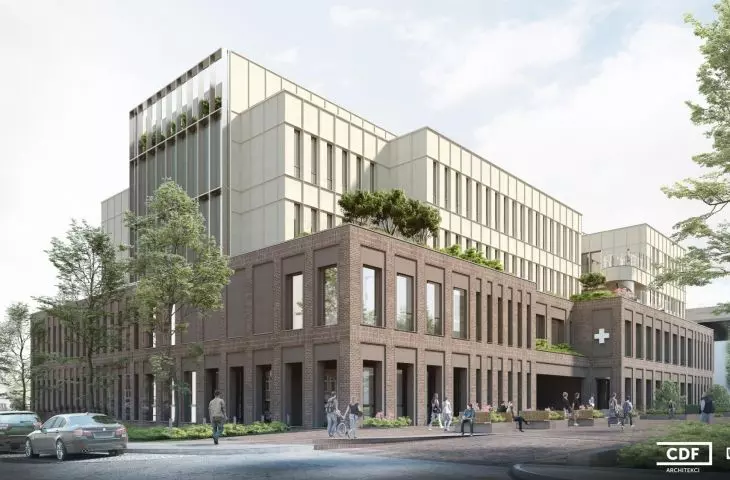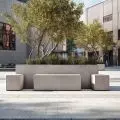Two years after the competition, construction of a new edifice for Poznan's W. Degi Orthopedic Hospital has begun. The building was designed by CDF Architekci and Ucees studios. The new wing, after minor modifications to the design, will complement the development of the historic Wilda district.
The Orthopedic and Rehabilitation Clinical Hospital has been operating in Wilda since the post-war era, when it was created and developed by its current patron, the famous orthopedist Professor Wiktor Dega. The facility is located at ul: June 28, 1956 and Krzyzowa in brick neo-Gothic buildings from 1871 built for a school and convent of the Sisters of the Sacré-Cœur. Later, from 1873, the Garczyński nursing home for the elderly and sick operated here. In the 1920s, the establishment donated the buildings to the University of Poznan, and a teaching hospital was then established in the reconstructed buildings.
Hospital wing and chapel, buildings of the former Sisters of the Sacré-Cœur educational institution
photo: Jakub Głaz
the only one of its kind
Taking over the buildings in the late 1940s and early 1950s, the orthopedists transformed them again. Between 1963 and 1970, a modernist rehabilitation center was built in the northern part, with an exceptionally successful accent of a lecture hall (designed by Maria Waschko, Waldemar Preis). In the southern part of the establishment there is an extensive park with old trees.
The lecture hall at the Dega Hospital in Poznan, part of the hospital's expansion, designed by Maria Waschko and Waldemar Preis (1963-1970)
photo: Jakub Głaz
On the other hand, even further to the north, on the side of Krzyzowa Street, in the area sloping down towards Dolna Wilda Street, the clinic had a large terrain reserve with a low single-story pavilion standing on it. And it is on this site (after the demolition of the pavilion) that the new hospital facility is being built. Thanks to it, the esteemed and beleaguered Wiktor Dega Orthopedic and Rehabilitation Clinical Hospital will be able to make optimal use of the talents of its doctors and ensure the comfort of both them and patients.
The construction site, view from Krzyzowa Street, the site after the demolished pavilion - the hospital and clinic building from the 1960s is visible (designed by M. Waschko. and W. Preiss), behind the building the crowns of trees of the hospital park
photo: Jakub Glaz
The building is being erected according to the design that won in a two-stage competition decided in June 2021, with the first prize going to a team of offices: CDF Architects (project leader) and Ucees (partner). Second place went to the office of Agnieszka Stochaj Architekt. Two honorable mentions were also awarded to Industria Projekt and a consortium of companies: Front Architects (leader) and Archimmodicus (partner).
The new building of the W. Dega Orthopedic and Rehabilitation Clinical Hospital in Poznan, visualization - proj. CDF Architects in cooperation with Ucees
© CDF Architects
sand instead of greenery
The winning design is a rather heavily sculpted mass consisting of different sized cuboidal elements. The building will have four above-ground and one underground floors, with the latter also visible from the east, due to the slope of the site. The composition of the mass is clearly divided into a more spread out and compact base, and the dissimilar, disjointed and smaller two top floors (with an overhang in the central part shielding the installations). The author's description reads:
These two different architectural layers create a façade that, when viewed in shortened perspectives, reveals its three-dimensionality. [...] The massiveness of the lower floors is emphasized by the use of sand-brown colored facade tiles on the facade and the use of plastered facade panels of an analogous color in the recesses.
The new building of the W. Dega Orthopedic and Rehabilitation Clinical Hospital in Poznan, view from Krzyżowa Street from the east, visualization - proj. CDF Architects in cooperation with Ucees
© CDF Architects
The use of tiles is a reference to the hospital's oldest brick buildings. The upper floors with simpler facades will be plastered. However, they will take on a different color than in the competition design. The Office of the City Historic Preservation Officer objected to the dim green of the walls. Instead, there will be a sand color. Common to the upper and lower elevations of the building will be rhythms of dense vertical divisions.
There is also another modification in the current design. The elevation on the side of Krzyzowa Street will have a lighter character and a clear accent on the closing of the Wierzbięcice Street axis. This will be done by emphasizing the staircase riser with a glazed mullion and transom composition. The original design featured a more massive wall here.
The new building of the W. Dega Orthopedic and Rehabilitation Clinical Hospital in Poznan, visualization - closing the view axis of Wierzbięcice Street
© CDF Architekci, Ucees
terraces from the ship
A noteworthy amenity for patients and employees are two spacious rest terraces, which will feature trees in generous pots. Space for patients is provided on the east side overlooking the greenery of John Paul II Park and the Warta River area. Hospital staff will rest on the west side. Both terraces are enlivened by accents of a winding staircase leading to the top floor with a form reminiscent of the nautical references of pre-war modernism. Other details and solutions, however, are not set in a similar language. What connects the new wing with modernism (visible next door in the 1960s building) is the additivity of the masses and their simple forms. However, it was not decided in the new section to show off formally to match the exceptionally successful lecture hall of more than half a century ago.
Lecture hall at the Dega hospital in Poznan - designed by Maria Waschko, Waldemar Preis (1963-70)
photo: Jakub Głaz
The facades of the lower part, moreover, refer to the tradition earlier than modernism, not so much thanks to the brick-like tile, but - above all - thanks to denser, then sparser vertical divisions and smooth panels. This solution certainly adds welcome variety to the massive massing, but it also - somewhat debatably - directs one's thoughts to 19th-century industrial architecture, of which there is none on Krzyzowa Street (there is only a small building of the old district power plant nearby). CDF Architects has been using a similar compositional solution more often lately, such as in the plaster facades of a residential high-rise building on Dąbrowskiego Street in Poznań (2021) or a yet-to-be-realized office building for the Poznań Fair.
Krzyżowa street and the construction site of the new wing of the Dega hospital - view from the west towards the John Paul II park
photo: Jakub Głaz
Shaping the relationship with the modernist building from six decades ago therefore came out more interestingly in the case of the work of the consortium led by Front Architects, which was awarded in the competition. In a hospital building, however, function is the most important thing, and it was probably this (and other apt solutions, such as terraces) that decided the winner. So how will the building, to which medical activities will be transferred from old facilities that are difficult to adapt further, function? The description informs that on the first floor
is designed for registration, doctors' offices and orthopedic clinics, plaster rooms, X-ray, EMG, ENG and ultrasound laboratories, as well as an analytical laboratory collection point and a hospital-run orthopedic store. [ The +1 floor houses an operating theater with 7 operating rooms, as well as recovery and intensive post-operative care rooms. The +2 and +3 floors are designed to house new pediatric bed wards.
main by streetcar
Thebasement, meanwhile, will house an orthopedic supply department, a hospital pharmacy, an analytical laboratory, a central sterilization room and a technical area. There will be two entrances to the new facility: the main one (which will henceforth serve the entire hospital) on the side of June 28, 1956 Street, with access to the nearby streetcar stop, and a second one on the east side , in the exposed part of the underground. From here, the closest access will be to the parking lot planned in the lower part of the plot along Krzyzowa Street (the target site for possible further expansion of the hospital).
The new building will be united by a two-story connector with the old part of the hospital, which in the future is to be used mainly for teaching and administration. It is also planned to house the Museum of Polish Orthopedics. Finally, mention should be made of the space for photovoltaics provided in the project , and solutions for retention on the hospital grounds. A line of trees in Krzyzowa Street along the fence of the hospital property is also to be preserved and supplemented.
The new building of the Dega Hospital in Poznan, competition visualization (before design modifications) - top view of the hospital complex; on the right, the oldest part from the 19th century with a park, in the center, the building from the 1960s. On the right: the oldest part from the 19th century with a park, in the middle: a building from the 1960s (on a T-shaped plan) with a lecture hall, on the left: a new building on Krzyżowa Street, at the bottom: 28 June 1956 Street; designed by CDF Architects in cooperation with Ucees
© CDF Architects, Ucees
A modern hospital building shaped in this way will certainly improve treatment and working conditions for medics, and - thanks to a sensible competition decision - complement well the space saturated mainly with historical buildings. Noteworthy is the apt placement in the urban context, the appropriate scale and the friendly character of the whole. We will evaluate the result in 2025, because then construction should be completed. There will also be an opportunity for comparisons. In Poznan, a new children's hospital opened a year ago, a new wing of the cancer hospital is nearing completion, and the first stage of construction of new facilities and the ED of the clinical hospital on Przybyszewskiego and Marcelińska streets is underway.






















































